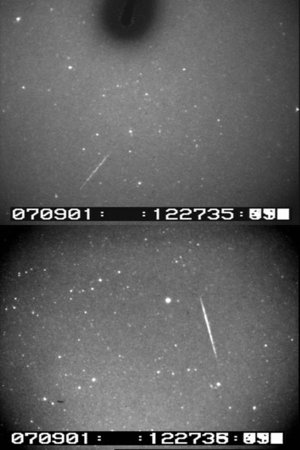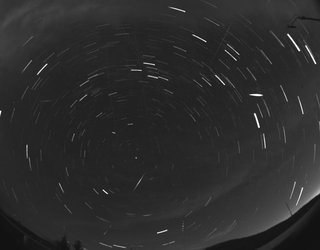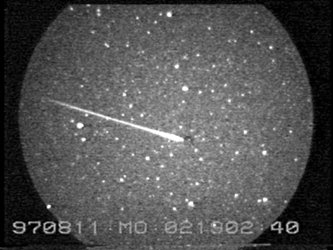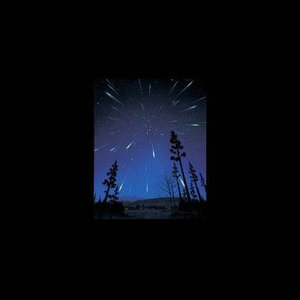First glimpses from the Perseid meteor shower
Enthusiastic observers were rewarded by a nice display of the Perseid meteor shower that was visible at its best in the night between 12 and 13 August 2007. We present glimpses of the spectacle and the scientific rewards of staying up all night.
The comet Swift-Tuttle orbits the Sun with a period of about 130 years. Whenever the comet comes close to the Sun in its orbit, it ejects a stream of dust particles, which are then distributed along its orbit. When the Earth passes through their path - a regular occurrence every August - we see a meteor shower, a fabulous spectacle for viewers on Earth. The last such ejection from Swift-Tuttle took place in 1992.
Due to the relative orientation of the orbits of Earth and the comet, the meteor shower appears to originate from the constellation Perseus. This is why it is called the ‘Perseid’ meteor shower. As dust particles enter the atmosphere, they interact with it and generate light before they disappear.
The Meteor Research Group of ESA performed coordinated observations at several locations in Austria and Germany in collaboration with the German Aerospace Center (DLR) and three other participating institutes - The ‘Institut für Weltraumforschung’, Austria, the Technische Universität Berlin, Germany, and the Max Planck Institute for Solar System Research, Germany.

The campaign had three main goals: to determine the orbits that the particles followed before they encountered the Earth, to study the physical properties of the dust by recording the light they emit (or their light-curve), and to test the performance of a new camera, known as the Smart Panoramic Optical Sensor Head (SPOSH).
The SPOSH camera, a highly sensitive instrument, is built for future use as a night-side imager of planets. It could also be used to observe meteors from space.
The test during the Perseid shower showed that the camera, which can image almost the complete sky, performed flawlessly. The top image, obtained with SPOSH during a 30-minute time frame with 2-second exposures, shows that stars appear to describe arcs around the pole star. The pole star itself shows up as a point, as it hardly moves during the exposure time. Meteors are visible as streaks crossing the path of the stars.
One of the cameras used by the ESA team was equipped with an objective grating, which splits up the meteor light into spectral colours. This allows the determination of the chemical composition of the particle.
About 30 meteors were recorded with this camera over about four hours. By combining this spectroscopic data with orbital data, it is possible to deduce the chemistry of the parent comet. This is done using models which describe how the dust particles lose some chemical elements with age.
With pairs of teams located from Northern Germany to Austria it was possible to use triangulation techniques to trace the individual trajectories of dust particles once they entered Earth’s atmosphere and the orbits of the meteors around the Sun (before they entered the atmosphere).
The orbits of the individual dust particles are similar to that of the parent comet Swift-Tuttle; however, they do not match exactly. Differences are introduced due to gravitational effects from planets and the influence of the Sun. Understanding these differences will shed light on the evolution of the dust particles in the Solar System, and on the ejection process of the particles at the comet.
The next scientifically interesting meteor display coming up is the Aurigid shower, a once-in-a-lifetime show originating from a long-period comet taking about 2000 years for each of its orbits around the Sun. The meteors from this comet reach us only every 70 years. It is expected to be visible from North America, Mexico, and Hawaii, with its peak on the morning of 3 September 2007.
Note for editors:
The SPOSH camera was developed by Jena-Optronics and DLR under ESA contract.
For more information:
Detlef Koschny, ESA Scientist
Email: Detlef.Koschny @ esa.int
Jonathan McAuliffe, ESA Research Fellow
Email: Jonathan.McAuliffe @ esa.int















 Germany
Germany
 Austria
Austria
 Belgium
Belgium
 Denmark
Denmark
 Spain
Spain
 Estonia
Estonia
 Finland
Finland
 France
France
 Greece
Greece
 Hungary
Hungary
 Ireland
Ireland
 Italy
Italy
 Luxembourg
Luxembourg
 Norway
Norway
 The Netherlands
The Netherlands
 Poland
Poland
 Portugal
Portugal
 Czechia
Czechia
 Romania
Romania
 United Kingdom
United Kingdom
 Slovenia
Slovenia
 Sweden
Sweden
 Switzerland
Switzerland




































